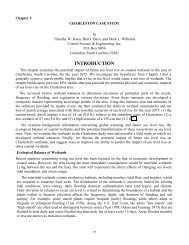A GEM Detector System for an Upgrade of the CMS Muon Endcaps
A GEM Detector System for an Upgrade of the CMS Muon Endcaps
A GEM Detector System for an Upgrade of the CMS Muon Endcaps
Create successful ePaper yourself
Turn your PDF publications into a flip-book with our unique Google optimized e-Paper software.
Abstract<br />
This technical proposal aims at instrumenting <strong>the</strong> 1.6 < |η| < 2.4 region <strong>of</strong> <strong>the</strong> <strong>CMS</strong> <strong>for</strong>ward muon<br />
system with a Gas Electron Multiplier (<strong>GEM</strong>) detector system to enh<strong>an</strong>ce <strong>the</strong> muon tracking <strong>an</strong>d<br />
triggering capabilities <strong>of</strong> <strong>CMS</strong> in <strong>the</strong> high-luminosity conditions expected after <strong>the</strong> second long LHC<br />
shutdown (LS2). Currently, <strong>the</strong> |η| > 1.6 region <strong>of</strong> <strong>the</strong> muon endcaps is not instrumented with <strong>an</strong>y<br />
<strong>of</strong> <strong>the</strong> Resistive Plate Chambers (RPCs) that were originally <strong>for</strong>eseen in <strong>the</strong> <strong>CMS</strong> Technical Design<br />
Report; it is proposed to instrument this vac<strong>an</strong>t space with Triple-<strong>GEM</strong> detectors.<br />
For <strong>the</strong> last two years, <strong>an</strong> international collaboration <strong>of</strong> <strong>CMS</strong> institutions has been studying <strong>the</strong> expected<br />
<strong>GEM</strong> detector per<strong>for</strong>m<strong>an</strong>ce <strong>an</strong>d its impact on future physics capabilities with muons in <strong>CMS</strong>.<br />
The collaboration has been evaluating <strong>the</strong> technological feasibility <strong>of</strong> such <strong>an</strong> upgrade with detector<br />
prototypes <strong>an</strong>d simulations. The results presented here show that a system with Triple-<strong>GEM</strong> detectors<br />
is a near ideal <strong>an</strong>swer to <strong>the</strong> stringent muon tracking <strong>an</strong>d triggering requirements in <strong>the</strong> expected hostile<br />
post-LS2 environment. This is due to <strong>the</strong> good position <strong>an</strong>d time resolutions, high rate capability,<br />
<strong>an</strong>d radiation hardness <strong>of</strong> <strong>the</strong>se micropattern gas detectors.<br />
Specifically, feasibility <strong>an</strong>d per<strong>for</strong>m<strong>an</strong>ce studies <strong>for</strong> two <strong>GEM</strong> stations (GE1/1 <strong>an</strong>d GE2/1) installed on<br />
<strong>the</strong> YE1 yoke disk are presented. The design, construction, <strong>an</strong>d per<strong>for</strong>m<strong>an</strong>ce <strong>of</strong> small <strong>an</strong>d full-scale<br />
trapezoidal Triple-<strong>GEM</strong> prototypes is described. Results on efficiency, space <strong>an</strong>d time resolutions<br />
<strong>of</strong> <strong>the</strong>se prototypes from detector simulations, laboratory measurements, <strong>an</strong>d muon/pion beam tests<br />
including measurements in a magnetic field demonstrate a per<strong>for</strong>m<strong>an</strong>ce fully adequate <strong>for</strong> <strong>the</strong> high<br />
background environment expected in <strong>the</strong> <strong>CMS</strong> muon endcaps during <strong>the</strong> high-luminosity LHC phase.<br />
Preliminary studies on <strong>the</strong> extension <strong>of</strong> <strong>an</strong> RPC-like trigger into |η| > 1.6 using a <strong>GEM</strong> system show<br />
signific<strong>an</strong>t sharpening <strong>of</strong> trigger turn-on curves <strong>an</strong>d improved trigger effectiveness compared with <strong>an</strong><br />
RPC-only trigger.<br />
Based on <strong>the</strong>se results, a baseline <strong>CMS</strong> Triple-<strong>GEM</strong> detector is proposed in detail <strong>for</strong> <strong>the</strong> upgrade.<br />
Large-scale chamber production scenarios are discussed, followed by integration <strong>an</strong>d installation studies<br />
given <strong>the</strong> existing <strong>CMS</strong> muon high-η envelope. The needed technical services have been studied<br />
<strong>an</strong>d <strong>the</strong> preliminary underst<strong>an</strong>ding <strong>of</strong> cooling, cabling <strong>an</strong>d gas distribution is presented. An initial design<br />
<strong>of</strong> on- <strong>an</strong>d <strong>of</strong>f-detector electronics <strong>for</strong> <strong>the</strong> readout <strong>of</strong> <strong>the</strong> <strong>GEM</strong> detector system is presented with<br />
a schedule <strong>for</strong> design <strong>an</strong>d production. Project schedule <strong>an</strong>d milestones towards installation in LS2<br />
(2017/2018) are projected; a budget draft <strong>an</strong>d <strong>an</strong> outlay <strong>of</strong> resources are presented. The org<strong>an</strong>isational<br />
structure <strong>of</strong> <strong>the</strong> collaboration that proposes to take on this project is discussed.<br />
Given <strong>the</strong> success <strong>of</strong> <strong>the</strong> feasibility studies <strong>an</strong>d with <strong>the</strong> org<strong>an</strong>isation <strong>of</strong> <strong>the</strong> <strong>GEM</strong> Collaboration in<br />
place, <strong>the</strong> project is ready to move ahead. Consequently, <strong>for</strong>mal review <strong>an</strong>d approval by <strong>CMS</strong> are<br />
requested. This will permit <strong>the</strong> project to be integrated into <strong>the</strong> <strong>of</strong>ficial <strong>CMS</strong> upgrade program enabling<br />
<strong>the</strong> participating institutions to approach <strong>the</strong>ir respective national agencies with funding requests <strong>for</strong><br />
<strong>the</strong> project.
















